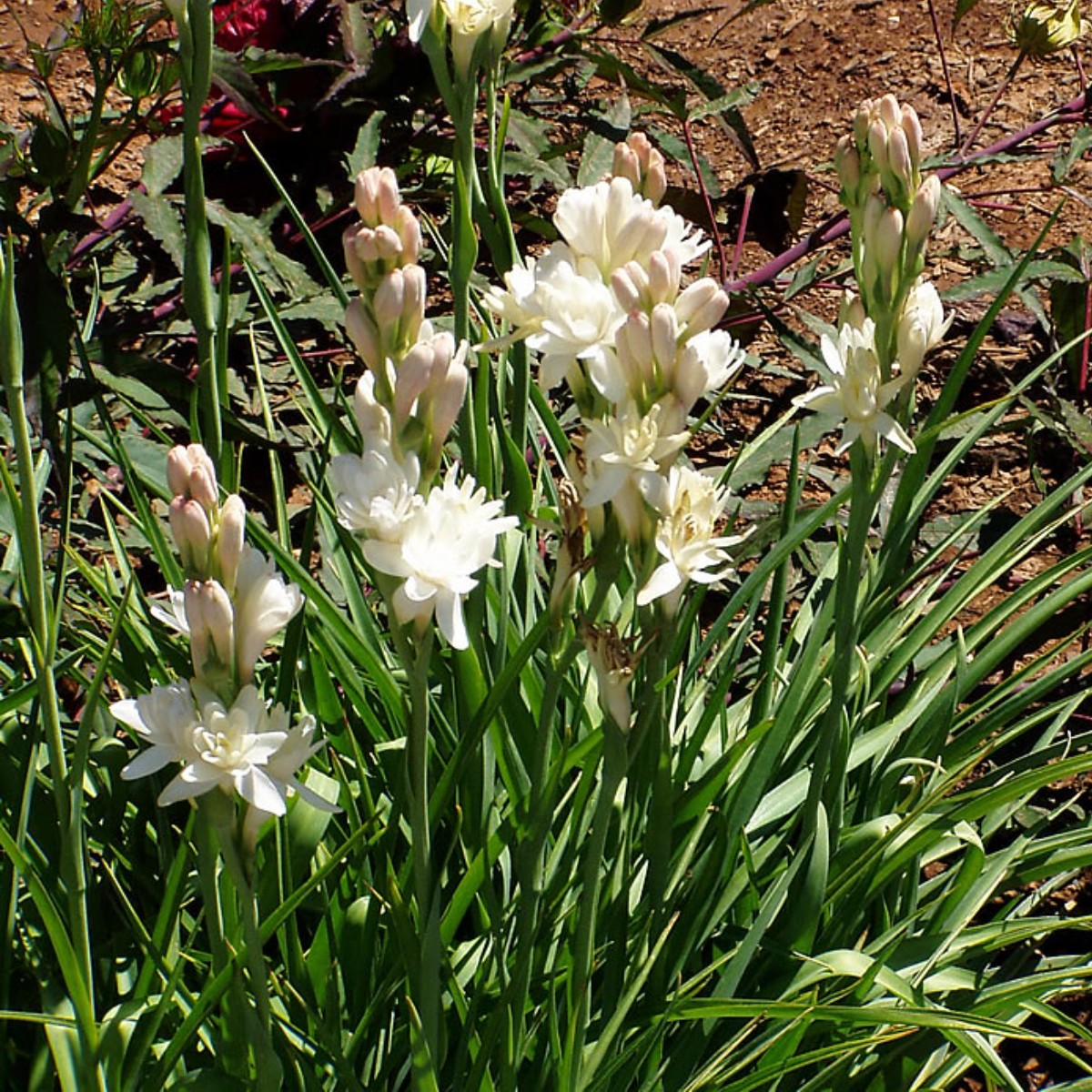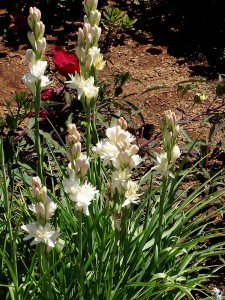Family: Asparagaceae
Distribution and habitat:Polianthes tuberosa is a night-blooming plant thought to be native to Mexico. It is not known to exist naturally in the wild today. In its natural habitat it prefers sites with friable, sandy soil with organic matter mixed in.
Description: Polianthes tuberosa is a plant related to the agaves. It is a herbaceous perennial tuber bulbous plant with erect leafy stems and broadly linear leaves. It grows in elongated spikes up to 45 cm (18 in) long that produce clusters of fragrant waxy white flowers that bloom from the bottom towards the top of the spike. The tubular flowers, 2.5 to 5cm (1-2 inch) long, occur in pairs, up to 30 flowers in a spike at the ends of the stems. It has long, bright green leaves clustered at the base of the plant and smaller, clasping leaves along the stem.
Bulbs that have bloomed once will not bloom again. Discard such old bulbs and replant the younger lateral crowns. Only mature bulbs will produce flowers. These younger offsets should flower in two years time prodded they are lifted and strip off the tiny bulbs attached to them after the first growing season.
The heady and heavily scented blooms are produced in late summer or early autumn and are as versatile and long lasting in the garden and container as they are when cut for the vase. The flowers are perhaps the most powerfully scented of all flowers and will continue to produce and exhale perfume long after it has been picked. Several blooms can appear on each stem. The flowers have a mild fragrance during the day and a strong fragrance during the night and last about a month.
Houseplant care:Polianthes tuberosa is suitable for containers growing as indoor plant.
Consider adding a plant support if the floral spike gets too heavy after bloom stalks form. Cut off the foliage once it yellows and dies back naturally in later summer or early fall as the plant is going dormant during the winter. A new cycle should be started in spring.
Light: Provide bright light for Polianthes tuberosa to successfully flower. It grows best with at least five to six hours of sunlight each day.
To force the plant to flower in winter, proper lighting in essential and should be used artificial lighting to ensure the plant receives the light it needs. It will need the equivalent of 16 hours per day of natural light. Turn lights on only during the daytime when the plant would receive natural light if it were planted outdoors.
Temperature: These plants require a temperature ranging between 21 and 24C (70-75F). Do not allow the temperature to drop under 15C (59F).
Water: Water the pot from the top until the excess moisture drains from the bottom and into the drip tray. Empty the drip tray. Water Polianthes tuberosa when the top 1 to 3cm (0.5-1 inch) of potting mixture just begins to feel dry to the touch.
Gradually reduce the watering in autumn when the foliage starts to yellow.
Feeding: These plants will respond well to regular applications of liquid fertiliser every three weeks throughout the growing season.
Potting and repotting: Pot the flowering bulb in a 15cm (6 inch) pot size filled with well draining potting mixture in mid-winter to early spring. Sow the Polianthes tuberosa bulb so the top of the bulb is 10cm (4 inch) beneath the soil surface. Water generously right after planting to soak the bulbs. Be sure that your pot has drainage holes in the bottom to prevent waterlogged roots. The planted bulbs will full bloom in roughly 4-6 months.
The bulb has to be repotted every several years in clean pots and fresh potting mixture. Repot these plants in spring when new bulbs can be separated for propagation proposes.
Garden Culture: Polianthes tuberosa are slow-growing, summer-flowering bulbs that need four to five months of warm weather and abundant moisture to bloom. In tropical climate, flowers can appear anytime from spring through fall.
Polianthes tuberosa are warm climate plants, but will tolerate light frosts in the garden. The bulbs should be bought in late winter and early spring to get them on time for planting. After flowering, do not remove the foliage as it continues to feed the bulb for next year's growth. This plant will become dormant over the winter. The leaves can be removed only once they have yellowed completely late in fall. These bulbs can remain outside in places with light freezes if well mulched. Prepare the bulbs for dormancy period by gradually reducing water (in cold regions, about three weeks before the first frost is expected). At this point, if digging up the bulbs for the next season is intended or needed, do so now. Allow the bulbs to dry in the open air and shade for several days, then place them in a paper bag or cardbox box filled with peat moss for winter storage indoors. Provide a cool and dry storage area for winter.
If grown in pots or containers, bulbs may be started indoors in early spring, bringing them outdoors to a sunny location after the threat of frost has passed.
Position: These plants should be grown in full sun to part shade. They need full sun for about 6-8 hours during the day.
For areas that reach summer highs temperatures of 35C (95F) or higher, plant these bulbs where they will receive partial shade during the hottest part of the day. Extreme heat can shrivel Polianthes tuberosa flowers or prevent buds from opening.
Soil: Polianthes tuberosa grows in fertile and well drained moist soil. Amend the soil at the planting site with a 10cm (4 inch) thick layer of compost to increase the nutrient content and drainage of the soil.
Plant the bulbs 8 to 10cm (3-4 inch) deep and 15 to 20cm (6-8 inch) apart and water in well. The flowers will appear about 90-120 days after planting, usually late summer or early autumn.
Irrigation: Water generously and regular as the Polianthes tuberosa is establishing itself. It requires frequent deep watering from the appearance of the first growth throughout the growing season. Do not overwater, as Polianthes tuberosa rots easily. Polianthes tuberosabulbs should receive water on a weekly basis.
Cease watering as the plant turns yellow in autumn when the bulbs go dormant.
Fertilising: Polianthes tuberosa flourish with generous feeding during the active growth phase. Add complete plant food once growth first appears and repeat fertilizing every 4-6 weeks.
Adding a thin layer of organic mulch over the surface of the soil helps prevent weeds and provides nutrients for the Polianthes tuberosa bulb.
Dormancy period: Bulbs can be left in their pots or dug up and stored, in a dry place and over-wintered. Also, within its hardiness zone, Polianthes tuberosa bulbs can be left in ground over winter. The parent bulb will form daughter bulbs and once these are thumb size, they can be grown next season. After the flowers are harvested, the leaves are allowed to die down, and the pots are put in a dark place until the Spring Equinox.
To care for Polianthes tuberosa bulbs in the winter, dig them up after foliage dries out. Allow to air-dry in the sun for about a week or two and store in a paper bag or box with peat moss in a cool location. They like storage temperatures ranging between 21 and 24C (70-75F) - but at least keep them in a place that is completely dry and the temperature is above freezing.
Propagation: Clumps can be lifted in late winter or early spring for propagation proposes.
Polianthes tuberosa reproduce fast and with time clumps will have several mature bulbs capable of blooming. Divide the tubers in early spring. Pull the bulb-like new tubers from the main tuber, separating each plant into several new ones. Plant the tubers immediately after dividing. Same operation is applied for both plants left in place over the winter and for bulbs dried and stored indoors during the winter.
Cutting flowers: Removal of the flowers for house display will not harm the plant. Cut flowers for vases when two or three of the lower blooms are opened fully. Remove spent flowers from the spike to prolong the life of remaining cut blooms. With care, this flower will last up to fourteen days. Use flower food solution. Trim off the very top buds to maintain the flowers straight length and to avoid the stem bending towards the light. Flowers with large stems last longer than those with smaller stems. Usually marketed as entire stems but individual flowers are sometimes utilized.
Problems: No particular pests or diseases.
Protect Polianthes tuberosa from snails and slugs.
Treatment: Use a snail & slugs bait.
Polianthes tuberosa bulbs are prone to rotting, so do not let them become waterlogged. Also, dry the roots thoroughly before storing.
Uses: Polianthes tuberosa is used as cutflower, feature plant or mixed border.
Place the plants near patios, walks, decks or other living space so that the fragrant flowers may be enjoyed to the fullest. In gardens these flowers will attract butterflies.
Known for their pungent fragrance, these flowers are popular at weddings and in cut flower arrangements.
Height: 90cm (35 inch)
Spread: 15cm (6 inch)
Hardiness zone: 8a-10b






